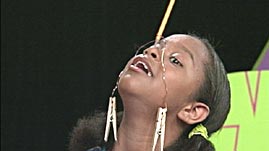All objects, including the pencil used in this
ZOOM activity, have a location inside them called the center of gravity. This is the point of balance, where the forces acting on one side equal those acting on the other side. Often the center of gravity is located near the center point of an object. However, depending on how equally mass is distributed throughout an object, it may be closer to one end or side than another.
Gravity pulls downward on all parts of any object. To counteract gravity and keep an object from falling, you have to push up on it with the same force that gravity is pulling down on it. If you push up exactly below the center of gravity, the force of gravity acting on one end of the pencil will be equal the force acting on the other end. When these forces are balanced the object remains stable. This location can be found easily in long, straight objects like pencils by balancing them horizontally on their sides.
To balance a pencil on its tip presents a difficult challenge because the pencil's center of gravity is far above the tip. With its center of gravity near its mid-point, a pencil supported at its tip balanced only when it is perfectly vertical. Small deviations, or tilts, to one side or another allow gravity to pull the other unsupported end downward, ultimately causing it to topple.
The solution the
ZOOM cast members come up with for balancing a pencil on its tip works by changing the location of the center of gravity. Adding weight, in the form of wire and clothespins, near or below the tip of the pencil moves the center of gravity toward, or even below, the pencil's tip. Consequently, the combination of these objects is much more stable and easier to balance from the pencil's tip than the pencil alone.


 Loading Standards
Loading Standards Teachers' Domain is proud to be a Pathways portal to the National Science Digital Library.
Teachers' Domain is proud to be a Pathways portal to the National Science Digital Library.
